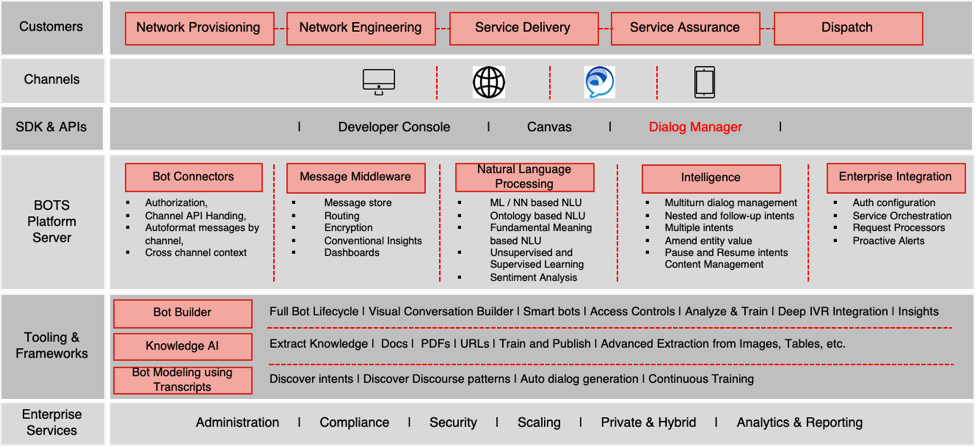Digital Network Assistant Chatbot for a Large Telecom Client
A large telecom client’s primary objective of this project is to help 10,000+ Network and Technology specialists across the globe ranging from circuit engineers to field operators who manage extremely complex provisioning, troubleshooting, and maintenance workflows under significant time pressure with a Digital Network Assistant.
The functional goals of this solution are: (1) Improved self-service capability, (2) Simplified information search, and (3) Easy Troubleshooting. Technical solution must enable users through a conversational interface on Web, Mobile, and Instant messaging platforms, and the Digital Network assistant must be available 24X7.
The functional scope of work of this project encompassed:
- Use the conversational interface to assist users in handsfree mode
- Integrate with multiple AI / ML platforms such as Google’s Dialog Flow, Amazon’s AI, etc.,
- Enable creation of multiple Bots or multiple instances of the same Bot to serve different groups across the globe
- Build an interface where business users without the technical background can create new intents and train the Bot with new skills
The technical scope includes:
- Building a platform to centrally manage the data, intents, skills to avoid conflicts and redundancy
- Building AWS infrastructure to manage and support Bot lifecycle
- Building the components and action handlers to fetch the corresponding data and display the information through an interface
- Building CI/CD pipeline to quickly develop, test, and deploy the new skills into production
- Building a user interface to help business and operational users to develop and train the Bot with new skills with code-less development architecture
The operational scope includes:
- Mining the skills of different groups and understanding the frequency of the usage
- Prioritizing the skills for development and quantifying the benefits
- Queuing the skills for development into Sprint Backlogs
- Training the new users on how to leverage Chatbot in their day to day tasks
Our Solution:
A chatbot is a tool to retrieve information and generate human-like conversation. It is mainly a dialog system aimed to solve/serve a specific purpose. To accomplish this goal, it needs an interface where the user needs to request dialog or keyboard; it needs NLP service to understand and interpret the command; it needs action handlers to connect with applications and retrieve the information so that the Bot can respond to the request. Also, it requires secured connections; authentication and authorization; store the data, dialogs, intents; orchestration services to synchronize requests from different users; messaging platforms from where users can make requests; and channels of service.
A Chatbot requires an interface to integrate with and all the plumbing to connect and retrieve the information on the surface. Hence designing and building the framework is essential to implement Chatbot to serve its purpose. The following figure illustrates the Chatbot framework.

The solution was built on the following best practices:
- Decouple the dependency between User Interface and NLP Backend – Every NLP comes with its own interface. It is in an organization’s best interests to develop its own interface and access NLP service through APIs. This helps easily changing the NLP service without much hassle.
- Save the intents and dialogs within the local database – This improves the performance and keeps it independent of the service provider.
- Design for multiple Bot Instances – Enterprises may either use one instance to cater to different business lines or use different instances with different names. Hence it is better to design for multiple instances.
- Develop different services – When different Chatbot instances are required, it is important to develop different services for Training, Testing, etc., to comply with multiple versions of different instances easily.
Benefits:
- Our solution reduced the time taken to complete the provisioning research tasks from 20 minutes to less than 3 minutes
- Our solution helped users to train 180+ skills in a period of 90 days, which resulted in significant productivity
- For the financial year 2019, our solution saved $13M


